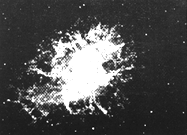Gamma Ray Bursts
Of all the high-energy photons beamed at us by the universe, probably none are
more puzzling than those emitted in gamma ray bursts. In the 1960s the US
launched a series of spacecraft with accurately timed gamma-ray detectors, to
monitor nuclear tests in space and later to enforce the international ban on
such tests. The idea was that by having several well-separated satellites note the exact arrival times of the radiation (gamma rays travel at
the speed of light) the sources of radiation could be pin-pointed.
The spacecraft indeed observed brief bursts of gamma rays, but the timing
suggested that they came not from Earth but from deep space. Later some fairly
accurate "fixes" were obtained for a few events and powerful telescopes were
trained on the indicated locations, but they saw nothing remarkable there.
There exists no generally accepted explanation for gamma ray bursts.s Some
promising theories were abandoned when NASA's Compton Gamma Ray Observatory
satellite (CGRO) found in 1991 that they seemed to occur equally in all
directions. Had they originated in our own galaxy, they would have probably
been concentrated in the direction of the Milky Way, where most of our galaxy's
stars are found (the galaxy is a flattened disk, and when we look at the Milky
Way we see it edge-on). The new evidence suggests that they could come instead
from distant galaxies, and if so, their sources must be incredibly powerful.
Added note: On March 2, 1997, the Dutch-Italian satellite BeppoSAX ("Beppo" was the nickname of the late Italian physicist Ochialini, after whom the orbiting observatory was named) reported a gamma-ray burst, and turned its x-ray telescope to the region. The X-ray telescope reported a continuing source of X-rays, and NASA's orbiting Hubble telescope (as well as the Keck Observatory on the ground) observed a visible "star" at the appropriate location, probably a distant galaxy. So far no definite conclusions have emerged (see Nature, 17 April 1997, p. 650).
Radio Waves
The other mode resembles the broadcast of radio waves from an antenna. A
radio antenna carries a rapidly alternating current which flows back-and-forth along it, and the back-and-forth motion (viewed from the side) of an energetic particle, when it spirals around a magnetic field line, acts the same way. ("Photon laws" apply here too, but because the photons are quite small, the "antenna viewpoint" may be used.)
Radio waves from space were discovered accidentally in 1932 by Karl Jansky, a radio engineer with the Bell Labs. Since then many radio telescopes have
scanned the skies and have discovered remarkable sources of radio and
microwaves. Often they seem to indicate high-energy particles; for instance,
some sources associated with distant galaxies suggest particles trapped in
enormous magnetic structures. Some come from the center of our own galaxy,
where linked radio telescopes thousands of miles apart have pinpointed an
extremely compact source, possibly a giant black hole.
Perhaps the best known sources of this class are pulsars, sources of radio pulses whose repetition rate is extremely regular. They seem to be "neutron stars," collapsed remnants left behind by supernova explosions, stars as massive as the Sun but as dense as the atomic nucleus, no larger than 6-8 miles across. The collapse also greatly amplifies any existing magnetic field and speeds up enormously the star's rotation, creating compact stars which rotate about once a second, sometimes faster, with extraordinary strong magnetic fields.
It is believed that the radio pulses come from particles spiraling in those
fields and that they are beamed in directions dictated by magnetic field lines.
Thus as the pulsar rotates its radio beam, like the light-beam of a lighthouse,
sweeps again and again past the Earth. The pulsing rate has been observed to
decrease very slowly, suggesting processes which gradually slow the rotation
down.
 The Crab Nebula
The Crab Nebula Official GSFC Home Page
Official GSFC Home Page  NASA WWW Home Page
NASA WWW Home Page